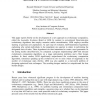443 search results - page 6 / 89 » Learning from a Population of Hypotheses |
SEKE
1999
Springer
14 years 2 months ago
1999
Springer
Today’s software developments are faced with steadily increasing expectations: software has to be developed faster, better, and cheaper. At the same time, application complexity ...
IIS
2000
13 years 11 months ago
2000
This paper reports briefly on the development of a new approach to evolutionary computation, called the Learnable Evolution Model or LEM. In contrast to conventional Darwinian-typ...
ICANN
2009
Springer
14 years 2 months ago
2009
Springer
The sequential structure of complex actions is apparently at an abstract “cognitive” level in several regions of the frontal cortex, independent of the control of the immediate...
BMCBI
2007
13 years 10 months ago
2007
Background: Quantifying cell division and death is central to many studies in the biological sciences. The fluorescent dye CFSE allows the tracking of cell division in vitro and i...
MCM
2011
13 years 4 months ago
2011
Molecular circadian clocks, that are found in all nucleated cells of mammals, are known to dictate rhythms of approximately 24 hours (circa diem) to many physiological processes. ...

